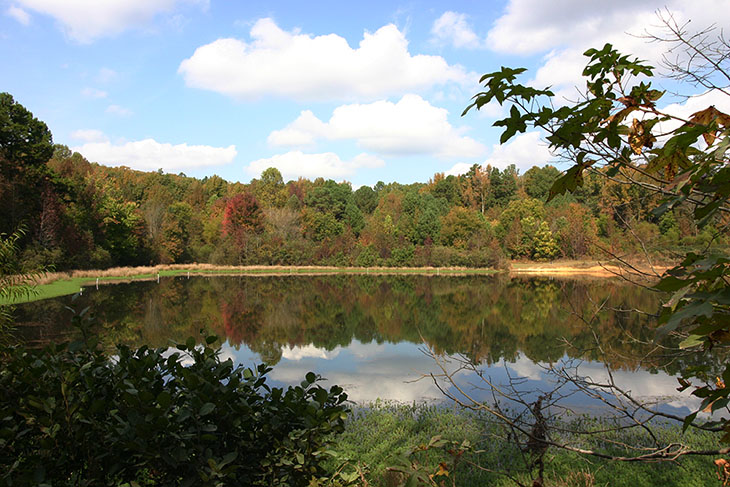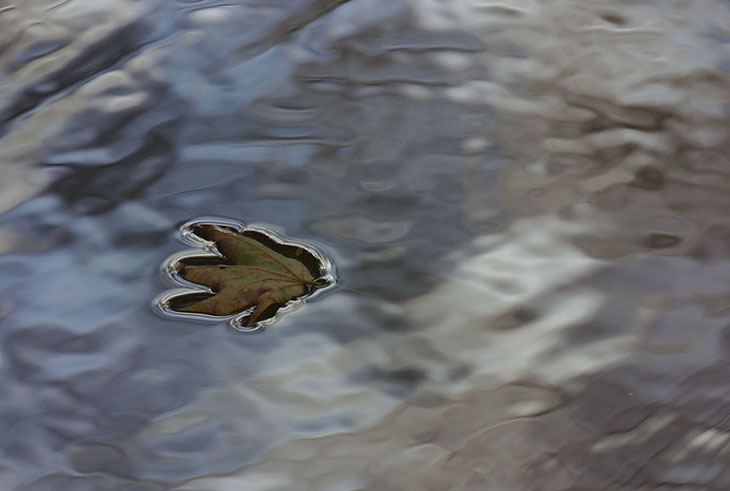
I’ve been watching the autumn colors developing slowly, wondering what this year’s conditions are going to be like. The pursuit of “peak colors” is a routine activity for anyone who chases landscape images, and some photographers and painters are quite dedicated to it, ensuring that they’re in a prime location in time to see the best displays. I’m not one of those photographers, and will likely not be traveling anyplace other than locally when the peak arrives. This area isn’t too fascinating for landscape shots, so I find what I can.
A quick note about the clouds above. First off, they’re blown out, exposed so highly that most of the detail is gone. Many photographers will tell you to avoid this, and it’s true, you usually want more shapes and contours to be visible. Yet, if I hadn’t pointed it out, I’m not sure how many people would even have noticed, since the clouds are just part of the setting, not the main subject, and still quite apparent what they are. I’m not excusing my mistake; I’m just saying that worrying too much about minor details is often blowing things out of proportion, and if I had exposed for optimum cloud appearance, the trees would have looked considerably darker.
Now, when you have clouds like this, move quickly – they generally represent changing conditions and will not be around long, nor will they remain in nice locations within the frame. Twenty minutes after getting this shot the sky had hazed over entirely from the climbing humidity, the blue was gone, and the light muted. I’ve done my share of waiting on clouds, and it’s safe to say the payoff is wildly sporadic. Many days you just give up and move on.
 The oak tree in the back yard ended up dropping most of its acorns before the leaves became very attractive, and because all but one branch are well enough above my head to make framing decent images difficult, I got nearly nothing out of it this year. When I found this one remaining acorn, I dodged around a bit to frame it against the sky, unable to get a position that put better light on the nut itself. When the broad vistas aren’t really up to snuff, you can still go in close for selective bits of color, or isolated subjects, and I’ve done a lot of work on those skills (notice that I did not say I was adept at it or anything.) You can produce nice seasonal nature images even in the middle of a city, if you’re choosy about what’s in the frame and don’t think that every image has to be a wide view.
The oak tree in the back yard ended up dropping most of its acorns before the leaves became very attractive, and because all but one branch are well enough above my head to make framing decent images difficult, I got nearly nothing out of it this year. When I found this one remaining acorn, I dodged around a bit to frame it against the sky, unable to get a position that put better light on the nut itself. When the broad vistas aren’t really up to snuff, you can still go in close for selective bits of color, or isolated subjects, and I’ve done a lot of work on those skills (notice that I did not say I was adept at it or anything.) You can produce nice seasonal nature images even in the middle of a city, if you’re choosy about what’s in the frame and don’t think that every image has to be a wide view.
Remember that you can make the light work for you too. Here the backlighting brings out the color of the leaves, which you can see were going towards the rattier end of their appearance. This time of year, the light often comes through gaps in the foliage, and may selectively highlight or backlight something interesting, so keep watching for the little tableau to appear. The sun’s moving across the sky, faster than we often think, and the conditions will change – a little patience can pay off, but it also means don’t hesitate when you see what you want, because it may also vanish quickly.
The fall of the acorns this year has been an experience, because some of them are coming from quite high up and the limbs overhang the house. From time to time a sudden clack! announces the impact on the roof, or a ricochet from the back porch against the storm door – this is a little annoying late at night. I’ve managed to escape being struck while out in the back yard chasing photos, but in two cases it was a near-miss thing. And I can’t walk barefoot out there anymore – I’m not that masochistic.
 I wanted an image to communicate how many acorns had littered the yard – seriously, the squirrels are going to die of obesity-related illnesses – but found the straight-down perspective to be a little boring, so I laid on my side and went for a different angle. Again, this could have been taken anywhere – the entire frame could be hidden under a book, but the proximity of the acorns is enough to indicate that there’s a lot of them.
I wanted an image to communicate how many acorns had littered the yard – seriously, the squirrels are going to die of obesity-related illnesses – but found the straight-down perspective to be a little boring, so I laid on my side and went for a different angle. Again, this could have been taken anywhere – the entire frame could be hidden under a book, but the proximity of the acorns is enough to indicate that there’s a lot of them.
Notice that these are different light conditions; bright direct light in this circumstance would have produced much more contrast and likely worked against the mood. A basic guideline for using light is to seek the low contrast subjects when the light is high contrast, and vice versa, even though in this case the subject was low contrast and so was the light. Most especially, when tackling very colorful subjects like fields of flowers, go with the softer light, which often means waiting for a passing cloud or hazy conditions. You can cheat sometimes and actually shoot within your own shadow. This technique can also help when trying to photograph subjects under the surface of water, very much so on days when the sky is hazy; direct light penetrates water well, but diffuse light just reflects from the surface, since it comes from all directions and it’s hard to choose an angle that doesn’t bounce it back into the lens. Shooting under a shadow helps a lot, but keep in mind that the reduction of light means that shutter speed might become an issue – moving ripples may also blur the subject.
Ripples are a nice compositional element to work with, by the way. They can produce very surreal effects from the reflections, and a nice texture when they’re frozen in time by the shutter. Always pay close attention to the water in your image, because what it’s reflecting is as much an element as whatever your main focal point is.

While the light conditions were bright this day, my shooting location was in deep shade. The water, once I’d shifted around a bit to my liking, reflected the blue sky, clouds, and the overhanging tree limbs. The surface tension curves around the edges of the leaf were a serendipitous discovery, throwing a patch of high contrast into an otherwise low-contrast image. I took several frames in the few seconds before the water carried the leaf away from the sky colors, and each one is different because of the ripples from the falling leaves – it’s not only a good idea to take a few frames just because we can’t know just how the ripples will appear until we see the images, but also wait for different splashes as well. A nearby ripple can throw accentuating curves around a chosen focal point, or alternately might create some clashing lines, so don’t be afraid to throw a lot of frames at a subject you like.
So, get out there and play!




















































